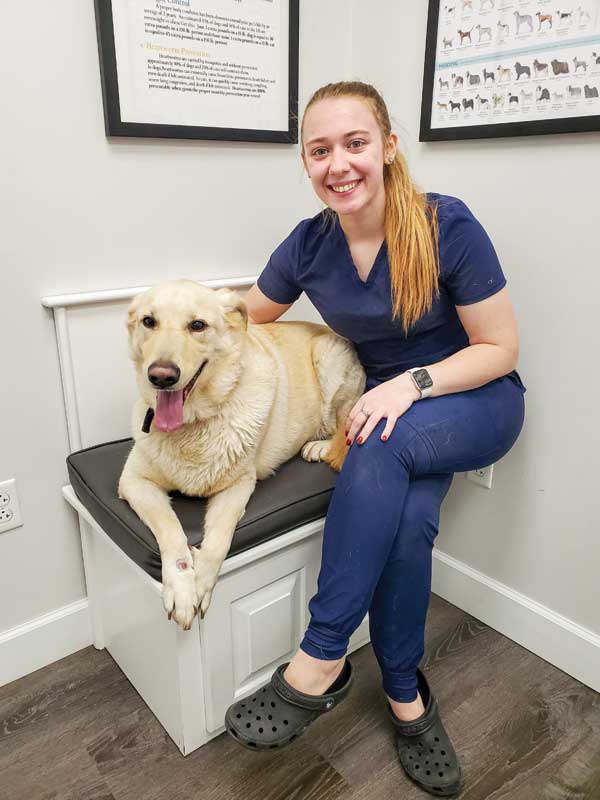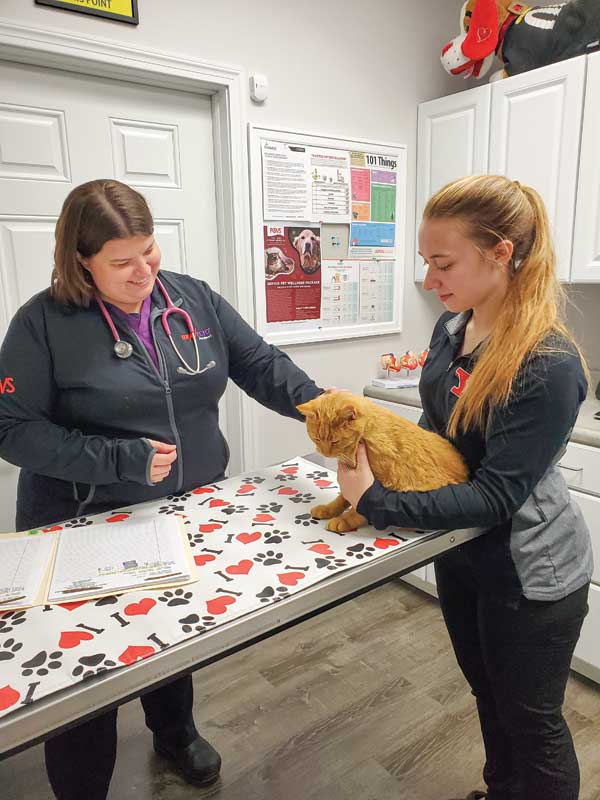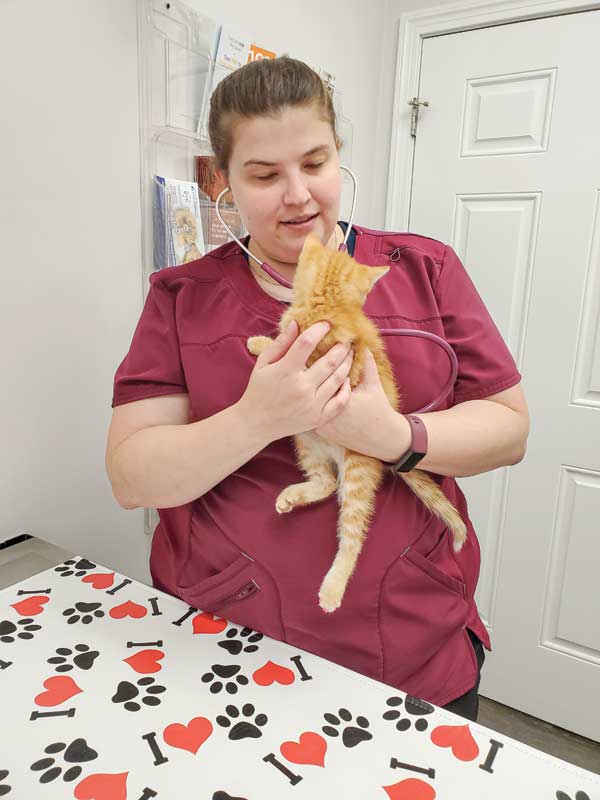
recommendations to clients across visits, regardless of which doctor is
examining the patient at a given appointment.” Photos courtesy Dr. Boatright.
Preventive care benefits not only the patients, but also pet owners, veterinary team members, and the practice. With pets being increasingly viewed as members of the family, owners gain satisfaction in finding ways to maximize their pet’s health.
Preventive care can also benefit client health, both directly, through the prevention of zoonotic diseases; and indirectly, through strengthening the human animal bond between themselves and their pet. Veterinary professionals can celebrate with clients when diseases are prevented or detected early, and can find satisfaction in delivering client education. Preventive care services bring revenue to the clinic at the time of the visit and can help bond clients to the practice, securing future revenue opportunities.
Despite the many benefits of preventive care, compliance with veterinary recommendations for routine examinations, vaccinations, parasite prevention, and screening bloodwork can often be poor. Prioritizing preventive care in your practice requires a team approach and willingness to identify and work around potential compliance barriers.
Engaging the team
Developing a protocol is the first step in prioritizing preventive care. At a minimum, this should outline standard recommendations on examination frequency, vaccination schedules, parasite testing and prevention, and screening lab work. These recommendations can be expanded and customized for individual patients based on breed, lifestyle, and age. Having a standard protocol allows team members to provide consistent recommendations to clients across visits, regardless of which doctor is examining the patient at a given appointment.
Once a protocol is developed, it is essential the team be engaged and educated in making recommendations to improve client compliance. When team members understand how the recommendations benefit the patient and client, they are more likely to be confident in speaking to clients. This is especially true for team members with less medical training, such as client service representatives (CSRs) and on-the-job trained veterinary assistants.
Team members in every area of the hospital should be given a role in promoting preventive care. CSRs can introduce recommendations when booking appointments or checking clients in to the hospital and forward book the next preventive care visit before the client departs. Veterinary technicians can be a primary source of client education on preventive care recommendations before the veterinarian ever enters the examination room or when helping prepare the client for future visits after the appointment. When veterinarians allow their credentialed technicians the opportunity to engage in client education, they show the value of their knowledge to the clients and can more efficiently use their
own time.
When recommendations are heard consistently and repeatedly from multiple team members, clients are more likely to perceive their importance. As they hear the same recommendations across multiple visits, the value is strengthened. Additionally, making consistent recommendations helps clients to prepare for the visit, both in knowing what to bring with them—such as a fecal or urine sample—and in knowing what to expect, such as how many vaccinations and that blood will be drawn. This can help reduce anxiety for the client coming into the visit as they are prepared for what will happen and may be more likely to approve recommendations such as wellness bloodwork.

Identifying compliance barriers
Even the most engaged, proactive team will have clients decline recommendations. It is how we respond that shows our commitment to preventive care. When a client declines recommended care during a preventive care visit, does your team just record the declined services and keep moving? Or do they take the opportunity to open a conversation with the client to better understand their reasoning? While some clients will volunteer the reason, they do not want preventative products or a certain vaccination, many clients will simply say “no” unless asked directly.
Using open-ended questions, a team member might say, “Can you tell me more about why you are declining the leptospirosis vaccine for Fluffy?” or “What concerns do you have about anesthetizing Buck for a dental evaluation and cleaning?” or “Can I tell you more about why we recommend year-round flea and tick prevention?” It is crucial these questions be presented in a non-judgmental way to encourage the client to respond openly and honestly.
While there are many potential barriers to preventive care compliance, they can generally be broken down into a few categories: cost, patient-specific factors, convenience, lack of perceived value, and fear.
Once barriers are identified, veterinary team members can work with clients to try to find a way to overcome the barrier. Below are a few strategies your staff can use to address common compliance barriers:
Cost. While cost constraints are the most common barrier to veterinary care at all levels, this is especially true for preventive care. For 80 percent of clients who were unable to receive preventive care over a two-year period, cost was the primary barrier.1
Cost barriers keep many pets and clients out of the clinic entirely, but for those who do come, finances can still be a limiting factor. Many pet owners underestimate the cost of their pet’s health. In a recent survey, 45 percent of dog owners and 38 percent of cat owners thought they were prepared for the costs of pet ownership but were not.2
Offering ways to spread expenses out over visits can help to work within individual client budgets. For instance, a pet owner could purchase parasite prevention monthly instead of a year’s supply at one time, or wellness testing could be scheduled as a technician appointment the following month.
Additionally, some clinics offer wellness packages that allow clients to pay over the course of a year for specific included services.
Preparing clients for future costs of care can also be helpful and is another advantage to having a preventive care protocol in your practice. For more costly preventive care services, such as screening lab work, introducing the recommendation a year or two before the preferred testing age can help clients prepare for the cost of additional lab work.
Lack of perceived value. Aside from cost, clients who do not see the value in the recommended services and products veterinary practices recommend can deter delivery of preventive care. This is especially true for annual examinations, which are often skipped when vaccinations are not due, and pets are seemingly healthy. Showing the value of the services we offer requires a commitment to client education both in the clinic and beyond through social media and community engagement.
When educating clients, the way we speak is essential. Most clients are not interested in hearing data and statistics. Instead, they want to hear personalized recommendations and discuss how a particular service will benefit their pet’s health, well-being, and their relationship with the pet.3 Inviting clients to share their concerns during an appointment allows them to not only feel heard, but provides opportunities to discuss how preventive care can help alleviate their concerns. For instance, if a client shares a previous pet was diagnosed with late-stage kidney disease, discussing how routine bloodwork can help with early detection may be especially meaningful.
Patient-specific factors. Even when clients are on board with our recommendations, their pets do not always cooperate. This can create stress or embarrassment for the client and lead to them declining procedures that require more restraint, such as blood draws, or avoiding annual visits altogether. Team members should be honest with clients about their pet’s behavior while remaining empathetic to the client and patient.
The best way to overcome barriers of patient cooperation in the clinic is to discuss pre-visit pharmaceuticals (PVPs) and techniques used to reduce fear. While some clients are hesitant to sedate their pet, explaining that PVPs are for the safety and comfort of the patient, as well as of the staff safety. Framing our recommendations in a way that shows how they benefit the pet and client is the fastest way to compliance.
Patient cooperation can also impact the ability of clients to administer preventatives at home. It is important when discussing preventative product options with clients that team members ask if a client feels their pet will accept an oral medication or if another route is needed. Clients may not be aware that preventatives are available orally, topically, and by injection, so there is often a solution for every pet family, we just need to take a few extra minutes to ask the right questions and discuss the options.
Convenience. While convenience may not be the biggest barrier to compliance, clients appreciate it when veterinary teams take the time to look ahead at what’s coming due soon and offer to combine services in a single visit if it can be done safely. If multiple appointments are needed, such as for booster appointments, CSRs should encourage clients to forward book their appointments so they can have a time that works best for their schedule.
Another convenience factor for clients is considering what parasite prevention your clinic carries and recommends. The best compliance with heartworm prevention is seen with long-acting injections because clients do not need to remember to give a monthly oral or topical medication. Newer oral preventatives that offer all-in-one protection for heartworms, fleas, ticks, and intestinal parasites can be a convenient option for clients to reduce the number of products they need to administer.
For many clients, products with longer duration are preferred so they have to administer or apply the product less often. Each client will be different, and team members can determine what fits the client’s lifestyle best by simply asking their preference.
For clients who purchase their preventive products month-to-month, practices can put reminders into their practice management system along with the routine vaccination and examination reminders. Additionally, if your practice uses an online pharmacy, encourage clients to enroll in an auto-ship option to eliminate the need to remember to place the monthly or quarterly order. In a few extra minutes during an appointment, a veterinary assistant or CSR can help clients enroll in this program and get ordering set up for them.
Fear. This is another common reason that clients decline our recommendations. Clients may decline vaccinations because of a concern for a reaction, preventative products because they read online that the product you are recommending kills dogs, or the recommended dental procedure because they are concerned their pet is too old for anesthesia. Much of this fear comes from myths, misinformation, and fear mongering online, but veterinary teams must be prepared to address these concerns in a
compassionate way.
Another place that fear can arise is in declining screening lab work. Some clients will decline, saying, “I don’t want to know if Penny has a disease,” or “I wouldn’t do any advanced treatment even if we found something.” In these instances, it can be helpful to respond in a way that shows clients they do not need to feel guilty for not wanting to pursue extensive treatment, but having the knowledge of what is happening in their pet’s body can ensure they are prepared for what may happen in the future and not be caught by surprise.

Key takeaways
Ultimately, veterinary teams must work together to promote preventive care in their practices. Once a protocol is developed, each team member can identify ways to educate clients about the recommendations. When recommendations are declined, teams should take the time to talk to clients about why they’ve declined. Engaging in compassionate, personalized communication with clients helps to strengthen bonds between clients, veterinary teams, and the practice and can often result in opportunities to overcome common compliance barriers.
Kate Boatright, VMD, is a small animal general practice and emergency veterinarian, speaker, and author in Western Pennsylvania. Dr. Boatright enjoys discussing mentorship, the spectrum of care, well-being, communication, and professional collaboration. In March 2023, Boatright authored the Veterinary Mentorship Manual, a resource for practices to help guide them in developing solid mentorship programs to support new graduates.
References
- Access to Veterinary Care Coalition. Access to Veterinary Care: Barriers, Current Practices, and Public Policy. Available at http://avcc.utk.edu/study.htm. Accessed October 25, 2023.
- Synchrony. Lifetime of care study. Accessed October 20, 2023. Available at www.petlifetimeofcare.com.
- McKay CH, Nichols N, & Lefebvre SL. Effectiveness of various language strategies for helping pet owners appreciate the value of preventive care. JAVMA 2023;261(8). https://doi.org/10.2460/javma.23.02.0060.
